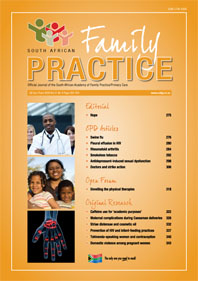Swine Flu: The Practitioners Guide for Dealing with the Influenza A, H1N1 Pandemic
Keywords:
Swine Flu, Pandemic, H1N1, Influenza A, treatment, confirmatory testing
Abstract
Within three months of its discovery, the new Influenza A (H1N1) swineflu strain has spread to such an extent that a pandemic has been declared by the World Health Organization (WHO). Although most cases seem to be mild, cases of severe disease have also been reported and by 6 July 2009, 94 912 cases and 429 deaths were reported worldwide. At this point the WHO concluded that further spread within and to new countries is inevitable and sustained community transmission will make it impossible to confirm all cases by laboratory testing. In South Africa the 100 case mark was reached on 16 July 2009 and the laboratory testing strategy was modified. All cases of suspected swine flu will no longer be tested by the National Institute for Communicable Diseases (NICD) although continued monitoring of cases of severe or fatal respiratory illness will continue. This also places the responsibility on the health care provider to manage mild cases, treat moderate to severe cases and request confirmatory diagnostic tests and report appropriate cases. This review aims to guide the clinician on these decisions.
Published
2009-08-17
Section
CPD
By submitting manuscripts to SAFP, authors of original articles are assigning copyright to the South African Academy of Family Physicians. Copyright of review articles are assigned to the Publisher, Medpharm Publications (Pty) Ltd, unless otherwise specified. Authors may use their own work after publication without written permission, provided they acknowledge the original source. Individuals and academic institutions may freely copy and distribute articles published in SAFP for educational and research purposes without obtaining permission.

